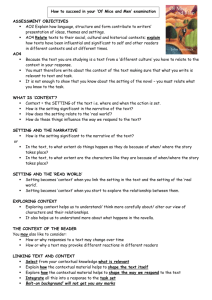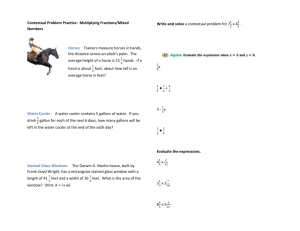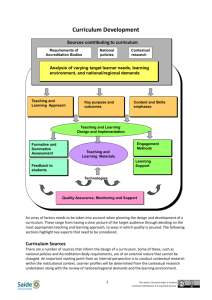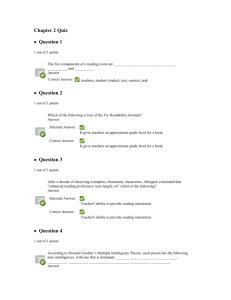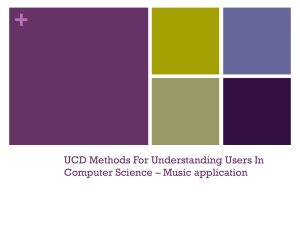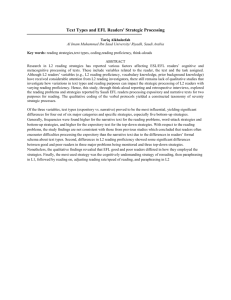successfully than lexical
advertisement
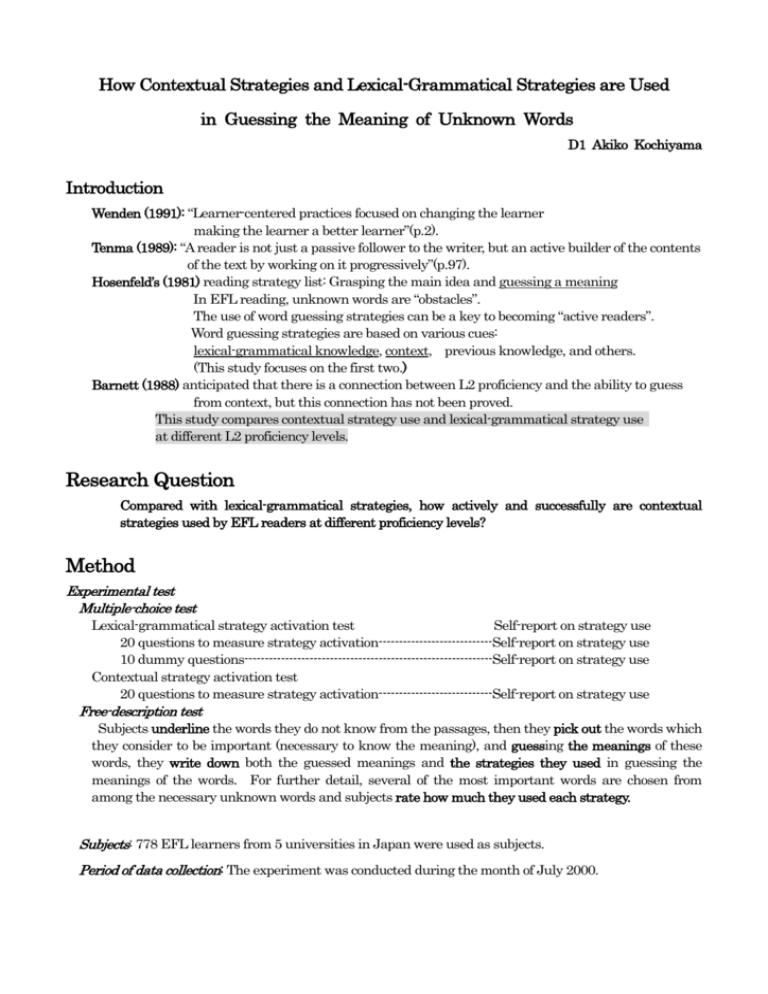
How Contextual Strategies and Lexical-Grammatical Strategies are Used in Guessing the Meaning of Unknown Words D1 Akiko Kochiyama Introduction Wenden (1991): “Learner-centered practices focused on changing the learner making the learner a better learner”(p.2). Tenma (1989): “A reader is not just a passive follower to the writer, but an active builder of the contents of the text by working on it progressively”(p.97). Hosenfeld’s (1981) reading strategy list: Grasping the main idea and guessing a meaning In EFL reading, unknown words are “obstacles”. The use of word guessing strategies can be a key to becoming “active readers”. Word guessing strategies are based on various cues: lexical-grammatical knowledge, context, previous knowledge, and others. (This study focuses on the first two.) Barnett (1988) anticipated that there is a connection between L2 proficiency and the ability to guess from context, but this connection has not been proved. This study compares contextual strategy use and lexical-grammatical strategy use at different L2 proficiency levels. Research Question Compared with lexical-grammatical strategies, how actively and successfully are contextual strategies used by EFL readers at different proficiency levels? Method Experimental test Multiple-choice test Lexical-grammatical strategy activation test Self-report on strategy use 20 questions to measure strategy activation----------------------------Self-report on strategy use 10 dummy questions-------------------------------------------------------------Self-report on strategy use Contextual strategy activation test 20 questions to measure strategy activation----------------------------Self-report on strategy use Free-description test Subjects underline the words they do not know from the passages, then they pick out the words which they consider to be important (necessary to know the meaning), and guessing the meanings of these words, they write down both the guessed meanings and the strategies they used in guessing the meanings of the words. For further detail, several of the most important words are chosen from among the necessary unknown words and subjects rate how much they used each strategy. Subjects: 778 EFL learners from 5 universities in Japan were used as subjects. Period of data collection: The experiment was conducted during the month of July 2000. Results and Discussion Figure 1: Results of the multiple-choice test Lexical-grammatical strategies are activated more often at the elementary than at the advanced level. Contextual strategy use significantly increases as the proficiency level increases (ANOVA test). Figure 1’: Results of the multiple-choice test (strategy use) --shows how actively the strategies are used Figure 1’’: Results of the multiple-choice test (successful strategy use) --shows how successfully the strategies are used Figure 1’ and Figure 1’’ show that as the proficiency level increases, contextual strategies are used more frequently and also more successfully than lexical-grammatical strategies. The difference in the steepness of the curves for contextual strategy use between Figure 1’ and Figure 1’’ shows that the success rate of contextual strategy use increases as the proficiency increases. Self-report on strategy use Advanced: good at assessing strategies Elementary: not good at identifying strategies, and assess their strategies to be “others” (lucky guesses) Figure 2: Results of the free-description test —shows that with higher levels of language proficiency, readers use contextual strategies more frequently and more successfully than lexical-grammatical strategies Figure 2’: Relative frequency of strategy use in the free-description test Figure 2’’: Relative frequency of successful strategy use in the free-description test From the elementary up to the intermediate-----lexical-grammatical strategy use greatly contributes From the intermediate up to the advanced-----contextual strategy use is necessary Self-report on strategy use Automatization: Contextual strategy use increases and lexical-grammatical strategy use decreases -----depends on how much the readers are conscious of using each strategy Advanced readers’ consciousness about their lexical-grammatical strategy use is lowered compared with intermediate readers. This lowering of awareness can be called automatization. Conclusion ・With higher levels of language proficiency, readers use contextual strategies more actively and more successfully than lexical-grammatical strategies. ・Automatization of contextual strategy use occurs after that of lexical-grammatical strategy use. Implications Based on the observations and analyses of this study, instruction can be given according to the level. ・From intermediate to advanced level, the teaching of contextual strategies should be emphasized, not only when guessing meanings but also when memorizing new words (ex.: integrating new words into the context). ・For elementary readers, instructors can effectively make use of their tendency to use lexicalgrammatical strategies by giving them word-based information. References Alderson, J.C. (2000). Assessing Reading. Cambridge: Cambridge University Press. Barnett, M.A. (1988b). Reading through context: How real and perceived strategy use affects L2 comprehension. Modern Language Journal, 72(2). 62. Hosenfeld, C., Arnold, V., Kirchofer, J., Laciura, J., and Wilson, L., (1981). Second language reading: A curricular sequence for teaching reading strategies. Foreign Language Annals, 14(5). Kochiyama, A. (2000). An empirical study on context-based strategies for guessing word’s meaning. JACET Bulletin, Vol. 32, 63-77. Nation, P. (2001). Learning vocabulary in another language. Cambridge: Cambridge Univ. Press. Tenma, M. (1989). Eibun dokkai no strategy. (Strategies for English Reading Competence). Tokyo: Taishukan Shoten. Wenden, A.(1987). Learner strategies for learner autonomy. New Jersey: Prentice Hall.
